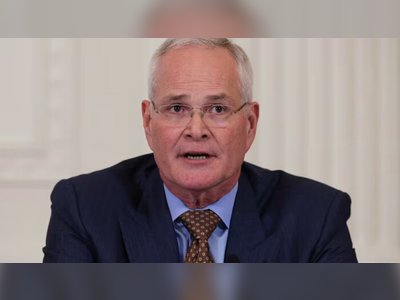
Further planning details revealed for cars on Hammersmith Bridge
Planning applications for the project are expected to be submitted by the end of April
Cars and buses won’t be allowed back across Hammersmith Bridge until at least 2026, but planning applications are being submitted next month for a temporary double-decker truss.
If approved, this will be placed at the historic site so vehicles and pedestrians can cross the Thames while parts of the 135-year-old bridge are moved off site for refurbishment and restoration.
Planning applications with both Hammersmith & Fulham and Richmond councils for the temporary truss are expected to be submitted by the end of April, with a procurement and funding phase to follow if successful.
If approved, including with support from Historic England, cars could be allowed back on the bridge in 2026 or 2027, Hammersmith & Fulham council confirmed on Friday.
Engineers have been working on the project since 2020 after cracks were discovered in the 1887 bridge along with other major defects in April 2019.
Foster + Partners lead structural engineer Roger Ridsdill Smith said: “It’s around 18 to 24 months to install the temporary truss so that vehicles and pedestrian traffic can use the truss for crossing.
“The whole process, including the refurbishment of the bridge and bringing it back and reinstalling, is around three years.”
The temporary bridge will allow for vehicles on the top deck and pedestrians and cyclists on the lower deck.
“We want to make it as beautiful and as as elegant as it can,” Mr Ridsdill Smith said.
“We’re aware it’s not the same and it’s not pretending to be the same as the existing suspension bridge.
“This is a temporary solution and the intention is to bring the existing bridge back.”
Cars will travel along the top deck because the bottom deck would be too narrow, causing “quite an imposition” for drivers, according to traffic engineers.
Foster + Partners could not confirm the cost of the temporary truss.
Prior to the closure, 17,232 cars and taxis crossed the bridge each day. It is estimated that 50 per cent of Hammersmith Bridge’s previous traffic went to neighbouring bridges.
To pay for the bridge’s restoration works, a road user charge or toll order are being considered, with a £3.25 fee for each motor vehicle being used as a benchmark. This has been opposed by Tory councillors at Wandsworth Council.
Any decision on pricing would have to be in line with the Mayor’s Transport Strategy and local authorities’ climate change ambitions.
A road user charge would require the Mayor of London’s agreement, while a toll order would come from the Secretary of State.
After the temporary truss is installed, the existing bridge will be cut into sections, lowered onto a barge and taken to a factory for refurbishment.
“You can take it apart and you can then do restoration works,” David Mackenzie, Senior Technical Director at Cowi UK, explained.
“If we find any defects, which we may well do, then those defects can be repaired in a factory setting.”
Signage, seating and lighting will also be improved on the historic bridge and there’s also an opportunity to widen the footpaths to improve the bridge’s accessibility.
This method is expected to cause the least disruption for residents, and avoid the need for a new temporary crossing to be built elsewhere on the Thames,which could raise issues with the Port of London Authority, the Environment Agency and affected residents.
The temporary truss can also be kept and used on other bridges that need repairing in future.
“What we’ve done is break that cycle of stop/start interventions on the bridge they’ve had for the last almost 50 years now,” Mr Mackenzie said.
There is currently no alternative proposal on the table.
The double-decker temporary truss plan is the “reference design” for the procurement and would see the bridge re-opening around two to three years sooner than under the previous Transport for London (TfL) and Pell Frischmann plan.
It’s unclear how much the entire restoration project will cost.
TfL funding was expected after the emergency closure of the bridge in 2019, but this fell through following the pandemic.
Hammersmtih & Fulham Council and TfL subsequently applied to the Government for funding on three separate occasions, all of which were unsuccessful.
The cost of repairs was estimated at a range of between £141m and £163m at that time.
The stabilisation works, after Hammersmith & Fulham and Mott MacDonald developed an alternative proposal, came in at £9m rather than £30m.
There are also inflationary pressures and optimisation bias that need to be considered. These are currently under discussion with the Department of Transport as part of a business case.
Hammersmith & Fulham Council are holding a series of local drop-in events to showcase the plans for the reopening of Hammersmith Bridge.
The annual Oxford and Cambridge boat race is taking place between Putney and Chiswick bridges on Sunday.
Although spectators used to stand on Hammersmith Bridge, this year it will be closed to pedestrians, cyclists and e-scooters from 11am to 6pm on Sunday, in accordance with safety advice.
If approved, this will be placed at the historic site so vehicles and pedestrians can cross the Thames while parts of the 135-year-old bridge are moved off site for refurbishment and restoration.
Planning applications with both Hammersmith & Fulham and Richmond councils for the temporary truss are expected to be submitted by the end of April, with a procurement and funding phase to follow if successful.
If approved, including with support from Historic England, cars could be allowed back on the bridge in 2026 or 2027, Hammersmith & Fulham council confirmed on Friday.
Engineers have been working on the project since 2020 after cracks were discovered in the 1887 bridge along with other major defects in April 2019.
Foster + Partners lead structural engineer Roger Ridsdill Smith said: “It’s around 18 to 24 months to install the temporary truss so that vehicles and pedestrian traffic can use the truss for crossing.
“The whole process, including the refurbishment of the bridge and bringing it back and reinstalling, is around three years.”
The temporary bridge will allow for vehicles on the top deck and pedestrians and cyclists on the lower deck.
“We want to make it as beautiful and as as elegant as it can,” Mr Ridsdill Smith said.
“We’re aware it’s not the same and it’s not pretending to be the same as the existing suspension bridge.
“This is a temporary solution and the intention is to bring the existing bridge back.”
Cars will travel along the top deck because the bottom deck would be too narrow, causing “quite an imposition” for drivers, according to traffic engineers.
Foster + Partners could not confirm the cost of the temporary truss.
Prior to the closure, 17,232 cars and taxis crossed the bridge each day. It is estimated that 50 per cent of Hammersmith Bridge’s previous traffic went to neighbouring bridges.
To pay for the bridge’s restoration works, a road user charge or toll order are being considered, with a £3.25 fee for each motor vehicle being used as a benchmark. This has been opposed by Tory councillors at Wandsworth Council.
Any decision on pricing would have to be in line with the Mayor’s Transport Strategy and local authorities’ climate change ambitions.
A road user charge would require the Mayor of London’s agreement, while a toll order would come from the Secretary of State.
After the temporary truss is installed, the existing bridge will be cut into sections, lowered onto a barge and taken to a factory for refurbishment.
“You can take it apart and you can then do restoration works,” David Mackenzie, Senior Technical Director at Cowi UK, explained.
“If we find any defects, which we may well do, then those defects can be repaired in a factory setting.”
Signage, seating and lighting will also be improved on the historic bridge and there’s also an opportunity to widen the footpaths to improve the bridge’s accessibility.
This method is expected to cause the least disruption for residents, and avoid the need for a new temporary crossing to be built elsewhere on the Thames,which could raise issues with the Port of London Authority, the Environment Agency and affected residents.
The temporary truss can also be kept and used on other bridges that need repairing in future.
“What we’ve done is break that cycle of stop/start interventions on the bridge they’ve had for the last almost 50 years now,” Mr Mackenzie said.
There is currently no alternative proposal on the table.
The double-decker temporary truss plan is the “reference design” for the procurement and would see the bridge re-opening around two to three years sooner than under the previous Transport for London (TfL) and Pell Frischmann plan.
It’s unclear how much the entire restoration project will cost.
TfL funding was expected after the emergency closure of the bridge in 2019, but this fell through following the pandemic.
Hammersmtih & Fulham Council and TfL subsequently applied to the Government for funding on three separate occasions, all of which were unsuccessful.
The cost of repairs was estimated at a range of between £141m and £163m at that time.
The stabilisation works, after Hammersmith & Fulham and Mott MacDonald developed an alternative proposal, came in at £9m rather than £30m.
There are also inflationary pressures and optimisation bias that need to be considered. These are currently under discussion with the Department of Transport as part of a business case.
Hammersmith & Fulham Council are holding a series of local drop-in events to showcase the plans for the reopening of Hammersmith Bridge.
The annual Oxford and Cambridge boat race is taking place between Putney and Chiswick bridges on Sunday.
Although spectators used to stand on Hammersmith Bridge, this year it will be closed to pedestrians, cyclists and e-scooters from 11am to 6pm on Sunday, in accordance with safety advice.











